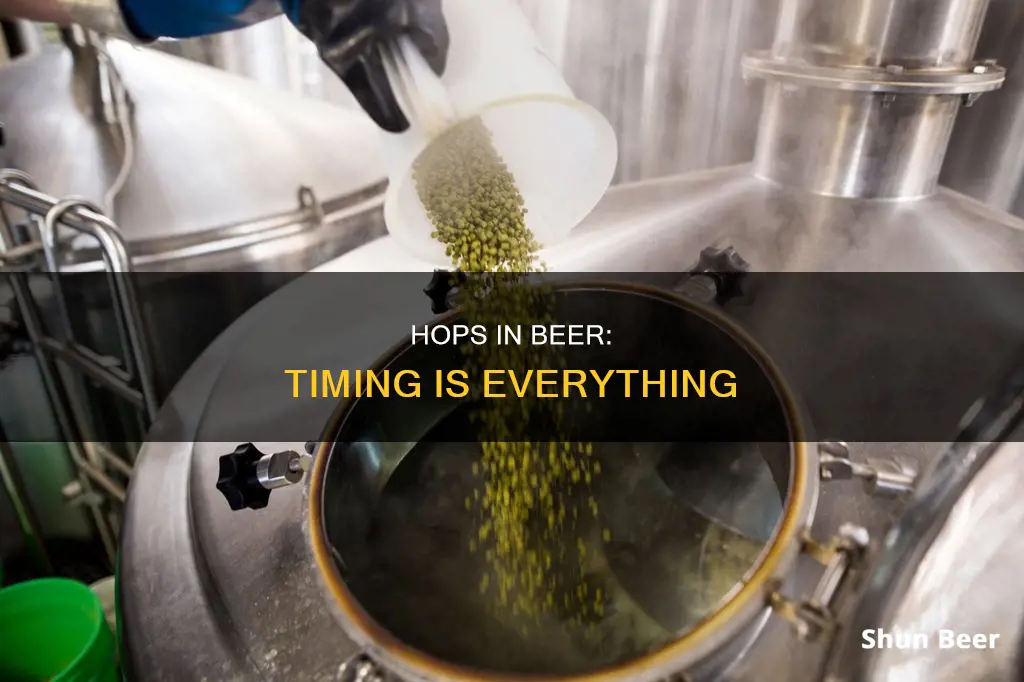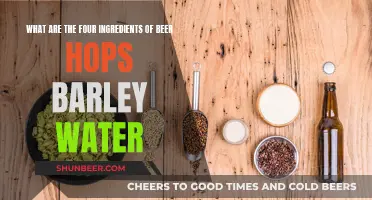
Hops are added to the beer-making process to add 'hoppy' aroma, flavour, and bitterness. They are usually added in three stages: bittering, flavouring, and aroma. However, some beers may have only one addition, while others may have up to five or six. Hops are typically added to the wort in the boil, with bittering hops added first, followed by flavouring hops, and then aroma hops. The timing of these additions is crucial, as the longer hops are exposed to heat, the more bitter the beer will become, and the less flavour it will have.
| Characteristics | Values |
|---|---|
| Number of hop additions | 1-6 |
| Purpose of hops | Bitterness, flavour, aroma, stability |
| When to add hops for bitterness | Beginning of the boil |
| When to add hops for flavour | Middle of the boil |
| When to add hops for aroma | End of the boil |
| When to add hops for stability | Throughout the boil |
What You'll Learn
- Hops are added at the beginning of the boil to create bitterness
- Hops are added during the middle of the boil to create flavour
- Hops are added at the end of the boil to create aroma
- Hops are added after the boil to preserve flavour and aroma
- Hops are added during fermentation to create aroma without bitterness

Hops are added at the beginning of the boil to create bitterness
Hops are added at different stages of the beer-making process to achieve different results. The three main stages are bittering, flavouring, and aroma. Hops added at the beginning of the boil primarily add bitterness to the beer.
The longer the hops are boiled, the more bittering compounds are created in the beer. This is because boiling the hops for a longer period of time leads to more isomerization, which results in more bittering compounds. Typically, bittering hops are boiled for around 60 minutes, although some recipes may call for as little as 30 minutes.
The type of hops used for bittering usually have higher concentrations of alpha acids, which provide the primary source of bitterness in the beer. These alpha acids are found in the resin glands of the hop cone and when heated, they go through a process called isomerization, which creates bitter-tasting compounds.
While any type of hop can be used for bittering, certain varieties are more commonly used for this purpose due to their higher alpha acid content. These varieties are often referred to as bittering hops or alpha hops.
It is important to note that the addition of hops for bittering is just one stage in the complex process of brewing beer. The timing and duration of the boil, as well as the type and amount of hops used, will vary depending on the specific recipe and the desired flavour profile of the beer.
The Evolution of Tropical Hops in Beer
You may want to see also

Hops are added during the middle of the boil to create flavour
Hops are added at different stages of the beer-making process to create different flavour profiles. Hops are typically added in three stages: bittering, flavouring, and aroma. The same variety of hops can be used for all three stages.
Hops added during the middle of the boil create flavour. The longer hops are exposed to heat, the more bitter the beer will become, and the less flavour it will have. Therefore, hops added during the middle of the boil will have a shorter exposure to heat, preserving their flavour.
The timing of the addition of hops is essential to producing the desired flavour. For example, hops added at the beginning of the boil will create bitterness, and hops added at the end will create aroma.
Most recipes will specify when to add the hops, either in terms of the time from the start of the boil or the time left in the boil. For example, a beer that is supposed to boil for 60 minutes may require hops to be added 30 minutes into the boil or with 30 minutes left.
Dry Hopping Tea in Beer: Enhancing Aromatics
You may want to see also

Hops are added at the end of the boil to create aroma
Hops are added at various stages of the beer-making process to create different flavours and aromas. Hops are typically added to wort in three stages during the boil: bittering, flavouring, and aroma.
Hops added at the beginning of the boil will create bitterness, while hops added during the middle of the boil will create flavour. However, hops added at the end of the boil will create aroma. This is because the hop oils responsible for the aroma are extremely volatile and will be driven off in the steam of the boil almost immediately. Therefore, aroma hops must not be boiled for long.
Aroma hops are typically added during the last 5 to 10 minutes of the boil or at flameout, which is when the kettle is removed from the heat. Adding hops at flameout will produce the maximum amount of aroma.
Adding hops at different times gives the beer more complexity. If only bittering hops are added, the beer will be missing something. By adding aroma hops, another dimension is added to the beer. Similarly, if only aroma hops are used, the beer will lack bitterness. Not enough alpha acids from the hops would be isomerized in the boil, and the beer would taste syrupy-sweet.
The Magic of Hops, Malt, and Barley in Beer
You may want to see also

Hops are added after the boil to preserve flavour and aroma
Hops are added to the beer-making process primarily as a bittering, flavouring, and stabilising agent. They are added at different stages of the process to impart different characteristics to the beer. Hops are typically added in three stages: bittering, flavouring, and aroma. However, the timing of hop additions is flexible and can vary depending on the desired flavour profile of the beer.
When it comes to preserving flavour and aroma, it is important to understand the delicate balance between extracting the desired flavours from the hops while minimising the loss of volatile aromatic compounds. Hops contain a variety of flavour compounds, including alpha acids, beta acids, and aromatic oils. The longer the hops are boiled, the more isomerisation occurs, leading to increased bitterness. However, boiling also drives off the volatile aromatic compounds, resulting in a loss of flavour and aroma.
To preserve flavour and aroma, hops are often added after the boil. This technique is known as "late hopping" or "post-boil hopping." By adding the hops after the boil, the aromatic compounds are better retained, as boiling temperatures can cause them to evaporate. Late hopping methods include flame-out, whirlpool, and hopback additions. During flame-out, hops are added immediately after the heat is turned off, reducing the temperature and preserving the aromatic compounds. Whirlpool hopping involves stirring the wort to create a whirlpool and adding the hops, allowing them to rest at lower temperatures to increase flavour impact. A hopback is a device packed with whole-flower hops that are washed with the post-boil wort, maximising the extraction and preservation of hop oils.
Additionally, dry hopping is another technique used to add flavour and aroma without boiling the hops. Dry hopping involves adding hops during or after fermentation, allowing the hops to impart their flavours and aromas without the need for heat. This method is commonly used by both homebrewers and professional brewers to enhance the flavour and aroma of their beers.
By utilising these late hopping techniques, brewers can better preserve the delicate flavours and aromas contributed by the hops while minimising the loss of volatile aromatic compounds. This results in beers with more complex and nuanced flavour profiles.
Hops Toxicity in Dogs: Beer Hops' Harmful Effects
You may want to see also

Hops are added during fermentation to create aroma without bitterness
Hops are added to beer during the boil in three stages: bittering, flavouring, and aroma. However, hops are also added during fermentation through a process called dry hopping. Dry hopping adds aroma and flavour without contributing any bitterness to the beer.
During the boil, hops impart bitterness due to the presence of alpha acids, which are isomerized and provide the bitter taste. The longer the hops are boiled, the more bitter the beer becomes as the alpha acids undergo a process called isomerization.
On the other hand, dry hopping involves adding hops to the beer after fermentation has begun, either in the serving cask, keg, or fermenter. This technique preserves the delicate volatile oils in the hops that produce flavour and aroma without boiling them off. The longer the boil, the more these oils are lost, which is why dry hopping is used to create a more intense aroma without the bitterness.
The right time to add hops during fermentation is when the fermentation starts to slow down, usually around three to four days after it has begun. This ensures that the beer's pH has dropped, preventing the growth of bacteria on the hops, and the alcohol content is high enough to kill any unwanted organisms. Additionally, the vigorous CO2 activity during the initial stages of fermentation can scrub the hop aroma from the beer, so it is essential to wait until this activity has decreased.
When dry hopping, the type of hops used can be either pellets or whole hops. Pellets initially float but eventually settle to the bottom, while whole hops tend to float on the surface. Pellets are more convenient and readily available, but whole hops may be preferred for those who want a slower release of hop oils into the beer.
The amount of hops added during dry hopping depends on personal preference and the desired intensity of the aroma. Typically, 1-2 ounces of hops are used for a five-gallon batch, but some brewers use up to 4 ounces or more for a stronger aroma.
Hops' Role in Extending Beer's Shelf Life and Stability
You may want to see also
Frequently asked questions
Hops are added at the beginning of the boil to create bitterness.
Hops are added during the middle of the boil to create flavour.
Hops are added at the end of the boil to impart aroma.







